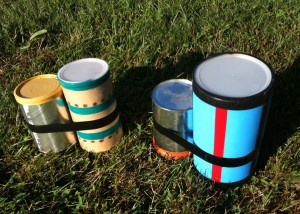One of the easiest drums for anyone to play are bongo drums. With roots in Afro-Cuban culture, this smaller set of hand drums is just the right size and shape to invite a child to sit down and tap and play away.
A Bit About The Bongos
Bongo drums are a great instrument for exploring rhythms and beats as well as Latin American culture with children. Originating in Cuba, there’s one larger drum, about 7 inches in diameter and one smaller drum, about 5 inches across. In Cuba, the bongo player is called a bongocero.
It’s easy to make a set of simple working bongo drum at home. All you need are a few basic materials starting with two round containers of different sizes. Coffee cans, oatmeal and corn meal containers work well for this project. Then you’ll need creative materials to decorate the two drums. Look for construction paper, stickers, colorful tape, markers or glitter and glue. Last, you’ll need sturdy tape – like electrical tape or duct tape – to attach the drums together.
Decorate The Drums
 Start by decorating the two drums. If you’re working with construction paper, cut out a cover for each drum and allow your child to design their drum on a flat surface. Then, tape the cover into place around each drum. If not, feel free to allow the child to decorate the rounded surface of the drum. Stickers and colorful tape, work well for this type of approach.
Start by decorating the two drums. If you’re working with construction paper, cut out a cover for each drum and allow your child to design their drum on a flat surface. Then, tape the cover into place around each drum. If not, feel free to allow the child to decorate the rounded surface of the drum. Stickers and colorful tape, work well for this type of approach.
Once you’ve completed the decoration process, use the electrical tape or duct tape and secure the drums together. Wrap the tape around both drums several times.
Now, you’re ready to play!
How Are Bongo Drums Held?
 Traditionally bongo drums are held between your legs, with the smaller drum to your left. However, if you’re playing with a child, feel free to place the bongos where it’s easiest for them to reach. This might be front of them on the floor or on their lap as they sit cross-legged.
Traditionally bongo drums are held between your legs, with the smaller drum to your left. However, if you’re playing with a child, feel free to place the bongos where it’s easiest for them to reach. This might be front of them on the floor or on their lap as they sit cross-legged.
Tapping Out A Beat
As always, I encourage the parent, caregiver or teacher to make a set of drums themselves and learn alongside their child. Here are some tips on basic techniques for beginner bongoceros, young and older!
Start by tapping the larger drum with your hands, using the upper part your palms (toward the base of your fingers). Tap the center, then other areas on the drum head and notice the difference in the sound. Do the same with the smaller head. Play back and forth between the larger and smaller head.
Next, try tapping the large head with one or more fingertips and you’ll hear a quieter sound. Try the same on the smaller head. Now you can mix and match the sounds you’ve just discovered and form them into patterns. Start simple and find patterns you enjoy or put on Latin American music and try to match the patterns from the song. You can also create new rhythm patterns that fit with the music you hear as well.
Once you’ve made your homemade bongos, feel free to use your new drums to “just jam” or to learn and play some of the great beats from Afro-Cuban and Latin American folk traditions. Here’s a basic bongo drum pattern called “el martillo” that almost anyone can learn with just a bit of practice.
Resources And Links
Bongo Craft PDF from TeachersPayteachers
http://www.teacherspayteachers.com/Product/Make-And-Play-Your-Own-Bongo-Drums-1430615
10 Music Crafts For Exploring Hispanic Heritage
Hear, Color Or Play a Guiro
http://www.dariamusic.com/guiro.php
Free Musical Crafts and Coloring Pages From All Over the World – From DARIA MUSIC


Great selection of resources thank you!